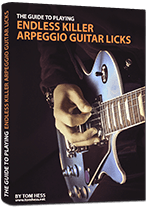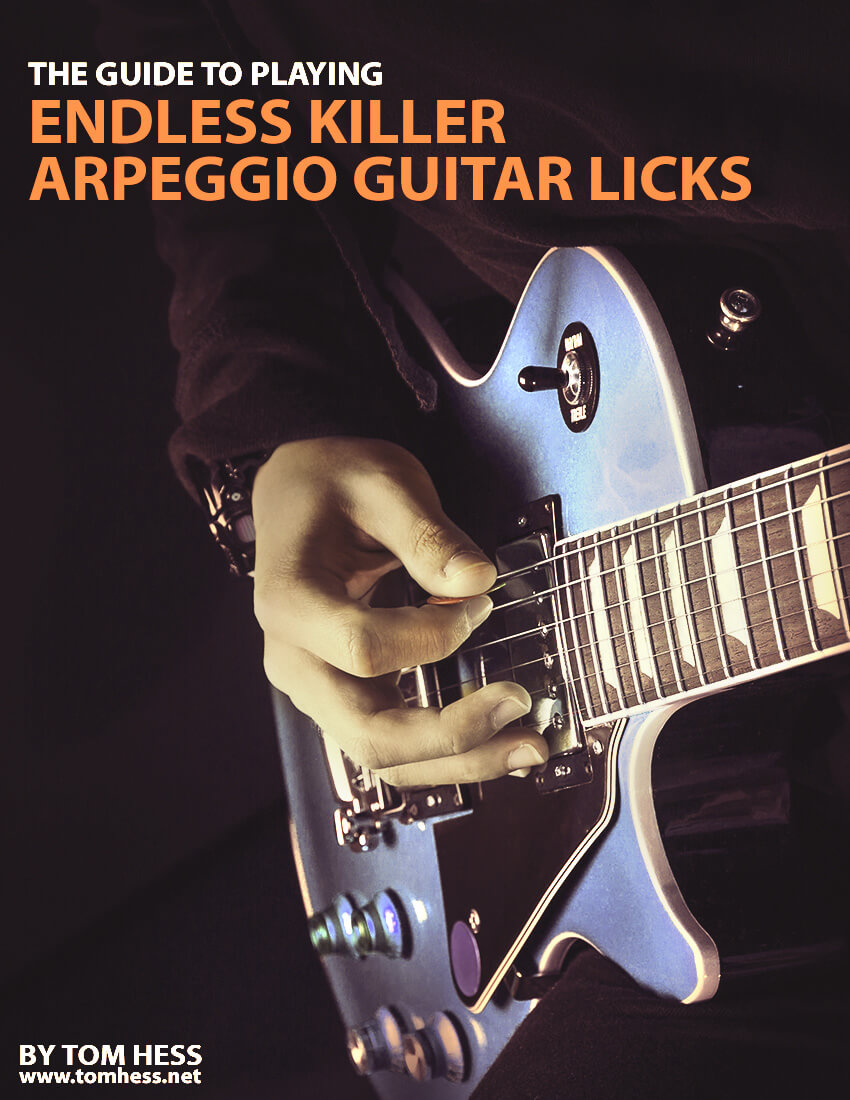Sweep Picking Lesson – How To Sweep Pick Faster And Cleaner

EMAIL TO GET ACCESS
By submitting your info, you agree to send it to Tom Hess Music Corporation who will process and use it according to their privacy policy.
If you’re struggling with sweep picking...
... this lead guitar article will help you refine your sweep picking technique and play guitar arpeggio licks faster and cleaner.
And even if you can already do sweep picking well...
I’ll show you simple guitar technique adjustments that will make your guitar arpeggios much easier to play.
(They'll also increase your guitar speed.)
Best part?
You don’t need to practice guitar a lot to get better at sweep picking.
You just need to focus on the right guitar technique elements in the right way.
Do that (even if it’s for a few minutes per day)...
... and your sweep picking will improve.

EMAIL TO GET ACCESS
By submitting your info, you agree to send it to Tom Hess Music Corporation who will process and use it according to their privacy policy.
Ready to begin?
To start...
Watch this video that lays out simple sweep picking guitar technique principles every guitarist ought to know:
Now that you know the basics of sweep picking guitar technique, let’s go deeper.
Here are 5 more sweep picking lead guitar tips that will improve your guitar technique:
Sweep Picking Guitar Technique Tip #1: Practice With Distortion To Clean Up Your Arpeggio Licks
There is this big sweep picking myth that you should play guitar arpeggios with a clean tone because (allegedly) “distortion masks mistakes”.
In reality, nothing can be further from the truth.
Clean tone actually masks more of your lead guitar technique mistakes than distortion does.
Why?
For one thing, there are different types of mistakes that can affect your sweep picking. They range from:
1. Articulation mistakes - for example: picking some notes louder than other notes in your guitar arpeggio licks.
2. Timing mistakes - for example: playing some notes faster than others. This sweep picking video shows what this mistake sounds like and how to fix it.
3. String noise mistakes - such as: open strings ringing out as you are playing fretted notes (making your lead guitar playing sound very sloppy).
Watch this video to see how to clean up sloppy guitar technique and make your arpeggio guitar licks sound clean:
4. Notes bleeding together - especially during finger rolling in your sweep picking licks. (Finger rolling is a name for a guitar technique where the same finger frets several notes on different strings.)
Watch this guitar arpeggio video that helps you clean up this element of lead guitar technique:
5. Technique errors - this is where you are not moving your hands correctly when you do sweep picking, which makes it virtually impossible to play guitar arpeggios fast. (Watch the sweep picking video at the top of this page to see how to best fix common sweep picking errors).
Of these sweep picking mistakes, clean tone only helps to spot the first one (articulation mistakes).
Distortion, on the other hand, exaggerates mistakes 3, 4 and 5… and mistake #2 can be heard equally well with both sounds.
The point?
Using distortion helps you spot your sweep picking mistakes (and thus - fix them) much more than clean tone does.
So, my advice is: use distortion (the same kind of distortion you’d use for your regular playing) as you practice sweep picking to make your guitar arpeggio licks sound clean.
Sweep Picking Guitar Technique Tip #2: Combine Sweep Picking With Tremolo Picking.
Using tremolo picking (picking a single note on the same string over and over) helps you improve your sweep picking guitar technique in 2 ways:
- Your sweep picking synchronization improves (which makes your guitar arpeggio licks sound cleaner at every speed (fast, medium and slow).
- You can create cool licks that sound very aggressive and intense - using just one guitar arpeggio shape.
Watch this video to see how to combine sweep picking arpeggio licks with tremolo picking:
Here is a simple guitar technique practice strategy that helps you combine sweep picking guitar arpeggio licks with tremolo:
Step 1: Choose a guitar arpeggio to practice (that you’ll use to combine sweep picking guitar technique with tremolo picking).
Step 2: Sweep up to the 2nd note in the guitar arpeggio using sweep picking.
Step 3: Tremolo pick the 2nd note in the arpeggio lick. You don’t need to use a metronome for this step and you don’t need to count the tremolo pick strokes. Simply go by feel.
Step 4: Sweep pick back down to the 1st note of the lead guitar arpeggio lick.
Step 5: Sweep up to the 3rd note in the guitar arpeggio and tremolo pick that 3rd note. (Again, go by feel and don’t count the tremolo pick strokes.)
Step 6: (Again) Sweep back down to the 1st note in the guitar arpeggio.
Continue sweep picking up 1 note at a time in your arpeggio lick and doing tremolo picking on the highest note.
This way of sweep picking adds a ton of fire and aggression to your arpeggio licks.
Question: “Tom Hess, how do I speed up my tremolo picking if it is not as fast as I want it to be?”
Answer: The key to tremolo picking speed is economy of motion. Move your wrist straight up and down when you tremolo pick. Do not rotate your forearm from side to side. (If you do, your guitar pick will move outside the trench (space) between strings, eating into your speed).
Watch this video that helps you speed up your tremolo picking without practicing more:
Sweep Picking Guitar Technique Tip #3: Rotate Your Focus From Note To Note.
When you’re having a hard time cleaning up a fast sweep picking lick, do this:
Do NOT slow down. Instead, zoom in (mentally) on the sound of just one note in your arpeggio lick – ignoring all the rest.
Check (and confirm) that the note you are trying to focus on is clean. If it isn’t, make the adjustment (in real time – without slowing down) to clean it up.
Only slow down if you cannot tell whether the note is clean or not at the speed you are practicing.
Then, rotate your focus to another note in the arpeggio and repeat the process.
Keep going until you’ve cleaned up every note in the arpeggio, without slowing down. Here is a video illustration of this way of practicing guitar arpeggios.

Question: “Tom Hess, what’s the problem with slowing down my guitar arpeggios to fix the mistakes I’m noticing?”
Answer: Some mistakes only become obvious past a certain tempo. This means when you slow down enough, you can no longer hear the guitar technique mistakes you are trying to correct.
And that means, you end up wasting a ton of practice time not improving your sweep picking at all… and likely - creating bad habits that you have to do.
That said, there is nothing wrong with ‘slowing down’ in and of itself when you practice your guitar technique.
And there are times when slowing down is the best way to clean up your guitar arpeggios. For example: when it comes to eliminating sloppy guitar string noise in your arpeggio licks… the slower the tempo - the more obvious the noise becomes.
The more obvious the string noise - the more it bothers you and the more likely you are to focus on fixing it.
Sweep Picking Guitar Technique Tip #4: Combine Sweep Picking With Tapping.
Sweep picking lead guitar arpeggios sound cool on their own…
But sweep tapping takes your arpeggio licks to another level. Sweep tapping sounds cool and can add a burst of speed to your guitar arpeggios with very little effort.
This video shows how to do sweep tapping the right way:
Here are a few more guitar technique tips for integrating weep tapping into your lead guitar arpeggio licks:
1. Use thumb muting during the sweep tap. When you move your picking hand to tap the highest of your lead guitar arpeggio lick, your picking hand’s thumb should be touching the lower (in pitch) strings - muting them.
2. Pay attention to the timing of the notes and make sure it is correct. That means: make sure that you’re clear on the length of the notes in the guitar arpeggio and don’t make the tapped notes longer or shorter.
3. Do double tapping. This is a fun (and easy) way to add more aggression to your sweep tapping lead guitar arpeggio licks, without having to practice more. As the name implies, all you do is tap a note two times before continuing with the rest of the arpeggio lick.
Double tapping sounds so cool because it interrupts the contour of the notes and surprises the listener with something they didn’t expect - building musical tension in the process.
Question: “Tom Hess, should I use the middle finger of my picking hand to do sweep tapping or the index finger (hiding the pick inside my grip like some guitar players do)?”
Answer: I recommend using the middle finger when playing sweep tapping lead guitar arpeggio licks.
The reason?
It’s much easier to continue playing other lead guitar licks (e.g. scale sequences) that require you to pick every note when your guitar pick is held like normal and you don’t need to make any adjustments to your pick grip after the sweep tapping part is done.
And speaking of pick grip…
Here is how I recommend holding the guitar pick for maximum speed and ease of playing:
Sweep Picking Guitar Technique Tip #5: Use Speed Bursts To Build Guitar Speed Without Slowing Down
What are speed bursts?
It’s a way of building speed with your sweep picking guitar arpeggio licks without using the boring “start slow and gradually build speed” guitar practice.
Here is how to practice using speed bursts to improve your guitar technique and lead guitar speed with sweep picking:
Step 1: Find your top speed of playing the lead guitar arpeggio lick you want to improve. Note: by ‘top speed’, I mean the top speed you’d feel comfortable recording the guitar arpeggio (and be happy with the sound of the notes, even if they are not as fast as you want them to be).
Step 2: Set the metronome to 10-25 bpm faster than that speed.
Step 3: Isolate a short chunk of the arpeggio lick (8-16 notes).
Step 4: Play the isolated chunk at the new (faster) tempo… ONCE. Then stop and pause.
Step 5: (The key step) During the pause analyze how the lick sounded and make a decision about what you might improve to make the fragment sound better and cleaner.
Step 6: Play the fragment again with the adjustment you decided to make in step 5. Then pause again and assess how the notes sounded.
Step 7: Continue steps 4-6 until the fragment is perfectly clean.
Step 8: Add 4-8 more notes to make the fragment longer and repeat steps 4-6 to practice playing the longer guitar arpeggio fragment at the new speed.
Keep going until you are able to play the entire arpeggio lick at the new speed.
Once you are, you can then crank up the metronome and take the lick through the same process once again.
Here is a video demonstration of this process in action:
Now that you know how to improve your sweep picking guitar technique, I want to help you create more expressive lead guitar arpeggio licks that sound cool and pro whether you are playing fast or slow. I show you how in my free eGuide: Endless Killer Arpeggio Guitar Licks. Download it today and discover the lead guitar secrets most guitarists will never know.


Improve your guitar playing with proven online lessons for guitarists.

